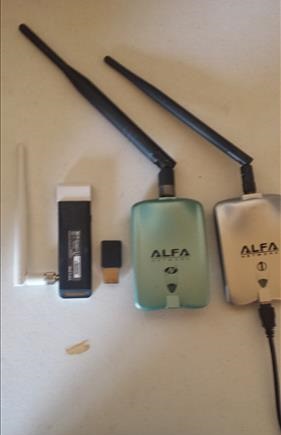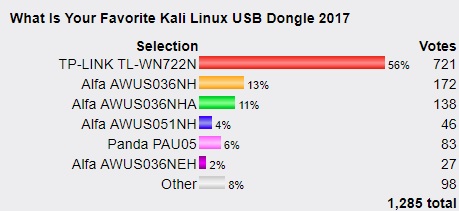Best Kali Linux Compatible USB Adapter / Dongles 2018

Anyone who wants to test a WiFi signals security will need a few tools, with a compatible USB adapter being the most important.
Kali Linux and Aircrack-ng is the most commonly used software with some other options also available.
Finding a good USB adapter is necessary since most dongles can not go into Monitor Mode and do the things that wireless Pen Testing needs.
What Makes a Kali Linux USB Adapter Compatible?
The Chipset and Drivers written for a card is what makes a dongle compatible with Kali.
To do wireless Penetration Testing a card must be able to go into Monitor Mode and do Packet Injections, most cards cant do this.
There are known chipsets that will work with Kali and Pen testing.
Most Popular Kali Linux Chipsets.
Atheros AR9271
Ralink RT3070
Ralink RT3572
Ralink RT5572
Realtek RTL8812AU
Ralink RT5370N
One thing to keep in mind is occasionally although rare manufactures can change the chipset in an adapter.
This happens when a new updated version of the adapter is introduced. Although it doesn’t happen often it has happened in the past with popular dongles.
Below is a list of the most popular USB adapters that work with Kali or Backtrack.
They also will work with most any Linux Distro that requires a wireless card to go into monitor mode.
To see which USB dongles are used the most we had a poll, here are the results.

Don’t forget to take the new Poll at the bottom of the page for your favorite Kali Linux USB adapter of 2018.
Top Best Kali Linux Pen Testing USB Adapters 2018
- TP-LINK TL-WN722N (Version 1 Only)
- Alfa AWUS036NH
- Alfa AWUS036NHA
- Panda PAU05
- Alfa AWUS051NH
- Alfa AWUS036NEH
- Panda PAU09
- Alfa AWUS036ACH (New Drivers)
Adapters that use the Ralink RT5572 chipset
Panda Wireless PAU09…….Amazon
Panda Wireless PAU09…….eBay
Read Full Panda PAU09 Review Here
Adapters that use the Ralink RT3070 Chipset
Alfa AWUS036NH 2.4 GHz…….Amazon
Alfa AWUS036NH 2.4 GHz…….AliExpress.com
Alfa AWUS036NH 2.4 GHz…….eBay
Alfa AWUS036NEH 2.4 GHz…….Amazon
Panda PAU05 2.4 GHz…….Amazon
High Power SignalKing Signal King …….AliExpress.com
Adapters that use the Atheros AR9271 Chipset
Alfa AWUS036NHA…….Amazon
UPDATE: TP-LINK TL-WN722N Chipset Change
TP-Link has released a new Version 2 of the TL-WN722N which does not work with Kali and Pen testing.
The Chipset for the TP-LINK TL-WN722N Version 2 has changed. If a TL-WN722N is bought be sure it is a Version 1.
TP-LINK TL-WN722N…….eBay
Adapter that use the RT3572 chipset
Alfa AWUS051NH Dual Band 2.4 GHz and 5.8 GHz…….eBay
Adapters that use the Realtek RTL8812AU Chipset
Alfa AWUS036ACH…….Amazon
The Alfa AWUS036ACH had new Drivers codded for it in 2017 that allows it to go into Monitor Mode.
This is big news since it is the first 802.11ac USB compatible Kali Linux adapter.
The Driver may need to be loaded with the command “apt-get install realtek-rtl88xxau-dkms”.
Wireless G only USB adapters, Realtek 8187L chipset
The following USB adapters are dongles that were best sellers in the past but since they only support wireless G they have become dated.
Alfa AWUS036H USB adapter 2.4 GHz…….Amazon
Netgear WG111v2 USB adapter 2.4 GHz…….Amazon
Sabrent NT-WGHU USB adapter 2.4 GHz…….Amazon
Summary
If you are new to Kali Linux and wireless Pen Testing finding the right USB adapter can be confusing at first.
Any of the above adapters will work with Kali and it comes down to which one is right for your setup.
For example if you are using Windows 10 with VMware to run Kali, the adapter will have to be Windows 10 compatible.
Some may want a longer range adapter to get a signal from farther away which an adapter with a bigger dBi antenna would be better with range.
Big adapters with big antennas are not very stealthy in which case a small USB adapter may be the better option.
For those who simply want to get started with Kali getting the cheapest dongle would be best.
Comments
Post a Comment